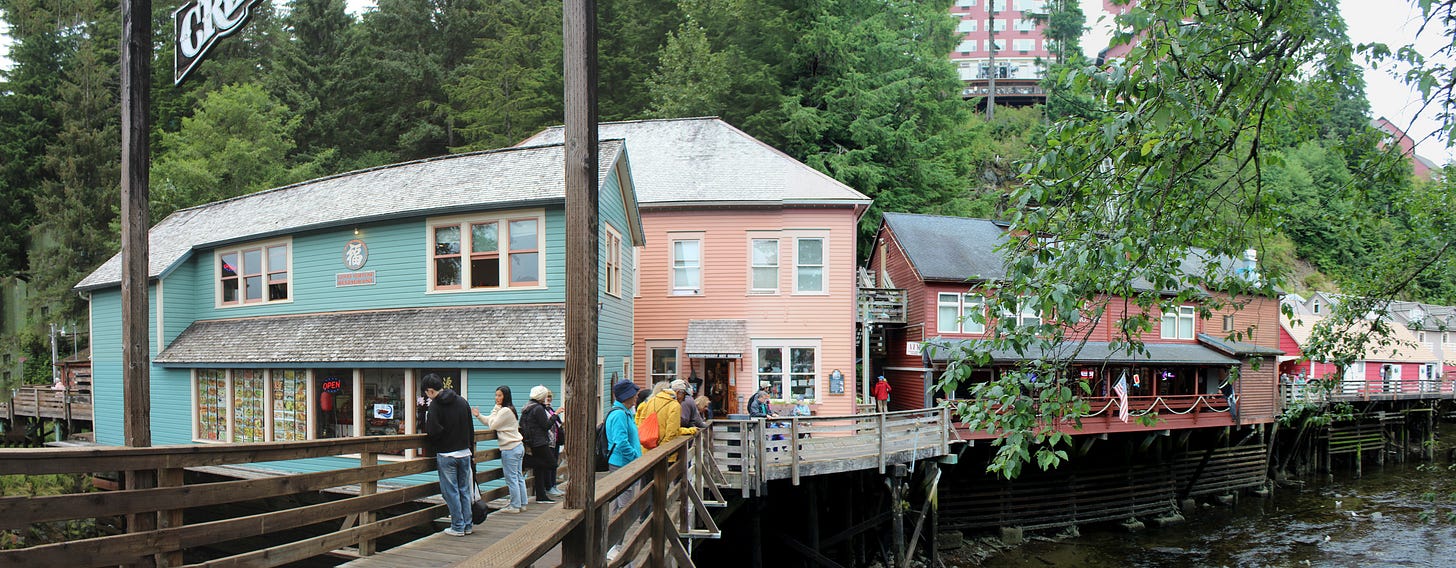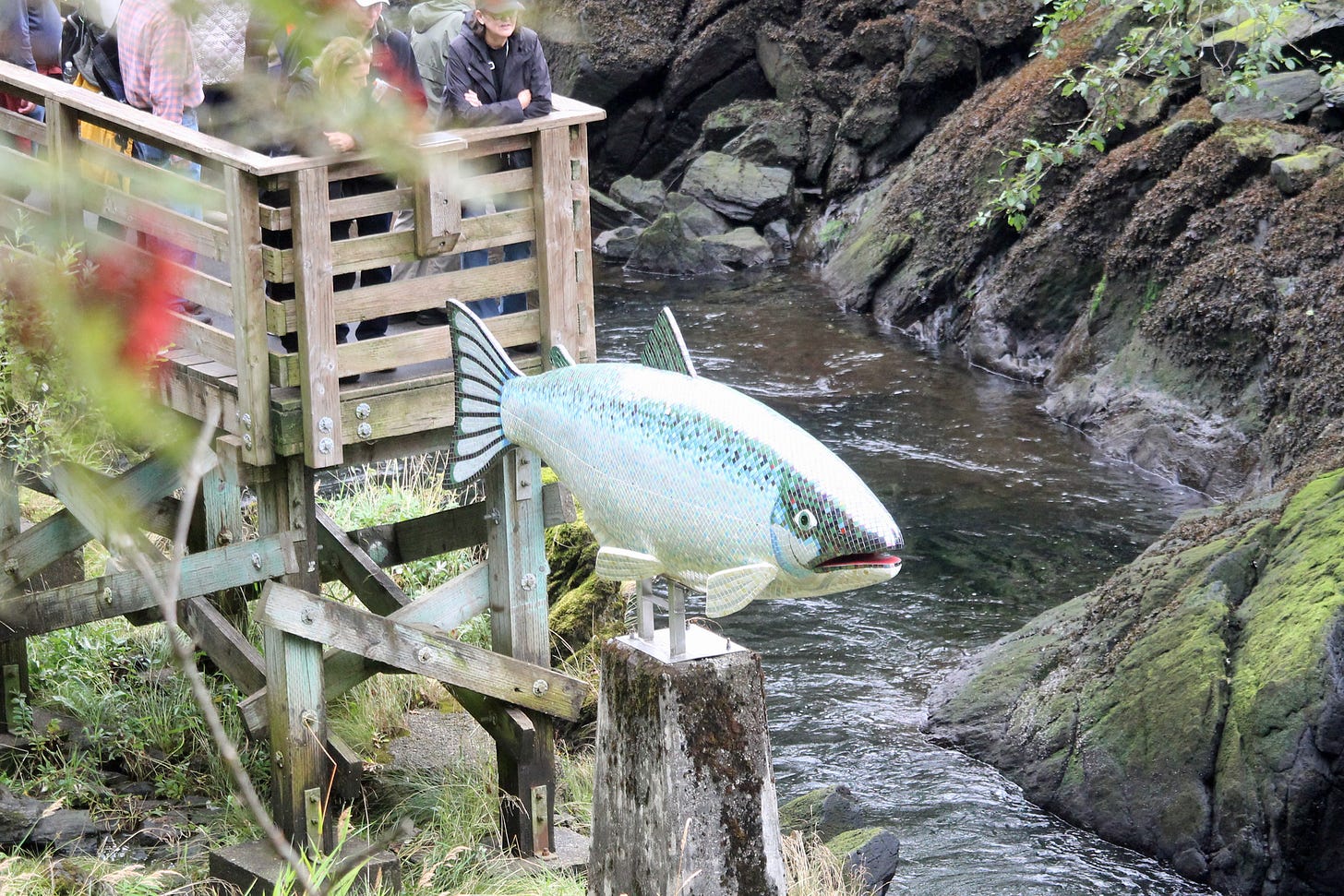The Pendulum # 22
Ketch Us If You Kan
My apologies for not having posted anything for a while. I’ve been busy as I’ll discuss later. Meanwhile, here is an account of our visit to Ketchikan, Alaska. On my travel blog I am calling it Where Both Men and Salmon Came Upstream to Spawn.
Our first port of call on our Alaska cruise was Ketchikan, and as the banner over Mission Street proudly proclaims, it’s the Salmon Capital of the World. And indeed, salmon created the city. The abundant fish lured entrepreneurs as early as 1885 and in 1890 a wharf and a cannery had been built. In 1900, with 800 citizens, the town was incorporated as Ketchikan, named after the creek the natives called Kich-xaan. The creek was also tapped to generate electricity. Industry grew with sawmills and mining. Ketchikan was Alaska’s largest city into the 1930s and had as many as seven canneries running at a time. (Thanks to Discover Ketchikan, 8th Edition for facts and figures. It’s a free magazine available at the tourist center.)
Cruises offer a variety of excursions you can take at each port of call but we opted to explore on our own and we’re glad we did. My sister-in-law was keen to see the salmon run and it was a short walk from the cruise ship to Ketchikan Creek. Soon we were at a bridge crossing the creek to a boardwalk on the other side, the prime viewing area for spawning salmon.
This composite picture above shows the bridge crossing Ketchikan Creek and part of the downstream area. The best viewing areas for salmon are upstream from the bridge.
The buildings on the south side of the creek are an area known as Creek Street. It has a colorful history of its own as we shall soon see, but first, let’s get to the salmon.
The boardwalk passes around the blue building and continues upstream, winding up some steps and around a corner. As the boardwalk passes the blue building you can see a large colorful diagram of some of the wildlife to be seen here, along with a legend explaining the different fauna.
The person putting this together certainly had a sense of humor as item 17 is listed as a troll under the bridge and item 19 is listed as Charles Darwin, homo sapiens. Three buildings are identified including the one sporting the large posters, Annie’s Place.
Continuing along the boardwalk one comes to a lookout point just beyond Annie’s Place. Just beyond that vista point is a large carving of a salmon. This is the Yeltatzie Salmon, named after Jones Yeltatzie, the Haida native who carved the original in 1963. Weathered and worn, it was replaced in 2013 by the current carving by Terry Pyles.
The salmon is pointing upstream and one can imagine the carving speaking to his live brethren, “Come on, guys! This is the way. Not much further. Don’t give up. You’re almost there!”
The video below shows a cascade running down under the Park Avenue bridge. The fish ladder at the right is available to circumvent the falls but most of the salmon seemed to prefer the more difficult route. The video salmon are hard to spot, but show up better in the closer up video that follows.
The next video starts with a closeup of the mass of salmon below the falls and then pans over where you can see them leaping up the cataracts though they are often pushed back to try again.
From spawning salmon we move on to spawning men! Say what?
With swarms of men coming into the city on cargo steamers to pick up salmon, there was a good demand for the world’s oldest profession. Bawdy houses were common. But in 1903, the city fathers decided to clean up the city by ordering all prostitution moved south of Ketchikan Creek and so Creek Street was born. An official red light district.
Because more than two female boarders constituted a brothel, most of the places opened were owned and operated by single women, sometimes with a partner. The one large bawdy house, the Star Dance Hall with twelve rooms, paid extra “protection” according to one of the many information signs in the area. The panoramic composite photo below shows Creek Street today.
By 1920, “31 ‘female boarders’ occupied 21 houses and after World War II some 33 houses were listed.” It was also a haven for bootleggers during prohibition. The houses weren’t shut down until 1954 in the midst of a scandal when the “indictment of the recently resigned police chief for operating a bawdy house and abetting bootleggers” rocked the city. (Discover Ketchikan, 8th Edition, p. 73)
The house in the center of the photo above is Dolly’s House. Built around 1905, the house was bought by Thelma Copeland who went by the name of Dolly Arthur, one of “Ketchikan’s most famous ‘sporting women'” as the information sign euphemistically puts it. She ran her business from 1919 through the 1940s and stayed there until 1973 when she moved to a nursing home.
Today Dolly’s is a museum showing the interiors as they may have looked in Dolly’s heyday. Tours are available for a modest fee. This blog post took its title from the large sign on the front.
The other prominent house we mentioned earlier. Annie’s Place. Annie Watkins was a black woman from Arkansas who bought the house in the 1920s. As the sign on the house notes, she was a fiery advocate for the women of Creek Street. “When holier-than-thou crusaders launched campaigns to ‘clean up’ the Creek, Annie countered with articulate letters to the editor.” She remained in her home until she passed away in 1966.
One of those holier-than-thou types was a preacher who ended up buying what is today the oldest remaining house on Creek Street and one of its earliest bawdy houses. He bought the place in the 1930s hoping to clean up the area. But this unnamed preacher changed the address from 28 Creek Street to 208 Stedman to avoid the stigma associated with the address. Needless to say, he failed in his endeavors. Today the house is a gift shop called The Captain’s Lady.
Creek Street was a lively place for salmon as well as for men and women. A colorful slice of Ketchikan history. The salmon still spawn here. The men, not so much. We very much enjoyed our visit to this historic area.
Here are links to a Photo Gallery that looks at other interesting spots around the city center. Our walking tour was fairly short, but one of the links is to walking tour map that covers a lot more territory.
Links of Interest
Where Both Men and Salmon Came Upstream to Spawn - this article at The Destinations Guru
Photo Gallery: Ketchikan - an additional collection of photos from my visit to Ketchikan at The Destinations Guru.
Ketchikan Walking Tour Maps (available for download. Do NOT click on the large ads on the page! They are junk.)
Meanwhile, I have been busy with a number of things, mostly reading. I have been on an Chief Inspector Gamache reading binge. If you’re not familiar with the name, the Chief Inspector Gamache books are a series written by Canadian novelist Louise Penny. I discovered her books after watching the Three Pines television series on Prime. I loved the series and picked up the most recent novel last year, A World of Curiosities. It’s a classic locked room mystery. It also has a parallel story that relates how Gamache and his right hand man, Jean Guy Beauvoir, first started working together. I then read The Madness of Crowds because the blurb sounded interesting. I followed that with the first book in the series, Still Life.
That was last year. This year I had been reading mostly non-fiction until my wife told me I had to read The Brutal Telling, # 5 in the series. Wow! It blew me away and I followed that up quickly with the next two books, Bury Your Dead and A Trick of the Light. Now I was well and truly hooked. I started by reding the three I had missed. Since mid-July I have read the following Gamache novels. Dates are the date I finished reading them.
The Brutal Telling (# 5) - July 20, 2024
Bury Your Dead (# 6) - Aug. 5, 2024
A Trick of the Light (# 7) - Aug. 18, 2024
A Fatal Grace (# 2) - Aug. 22, 2024
The Cruelest Month (# 3) - Aug. 31, 2024
The Hangman (# 6.5) - Sept. 11, 2024 - it’s numbered 6.5 as it is a very short novel written at a Grade 3 level for teaching literacy to adults. It was also used in the Prime TV series.
The Beautiful Mystery (# 8) - Sept. 16, 2024
How the Light Gets In (# 9) - Sept. 18, 2024
The Long Way Home (# 10) - Sept. 21, 2024
In that time I read only two other books, The Hunchback of Notre Dame by Victor Hugo and Intellectuals by Paul Johnson. Yesterday (Oct. 1st) I finished reading Knowledge, Reality, and Value: A Mostly Common Sense Guide to Philosophy by Michael Huemer.
All are fascinating and I want to write reviews of Hunchback (as well as of the 1939 movie), a review of Intellectuals, an exposé on Marx based on Intellectuals, an article on intuitionism (covered in the Huemer book as well as in Jonathan Haidt’s The Righteous Mind - this article needs more research before I write it.) and, of course, travelogues on Alaska. I just finished writing a music blog post on Songs About the Frozen North.
With all this reading as well as other distractions, I have had little time to write.
I’ve been rethinking this blog and will not publish further travelogues here, just on The Destinations Guru. It will probably take me half a year to write them all. What I do want to post here is the Introduction to The Pendulum. It’s not written yet, but I want to get down a fleshed out outline of the book. I already published a rough outline in The Pendulum # 9. I’ll try and write that for the next installment.
I’m also thinking about how often I want to publish The Pendulum. I was trying for one a week, but may make that one or two a month. In any event, here are a few more links of interest.












